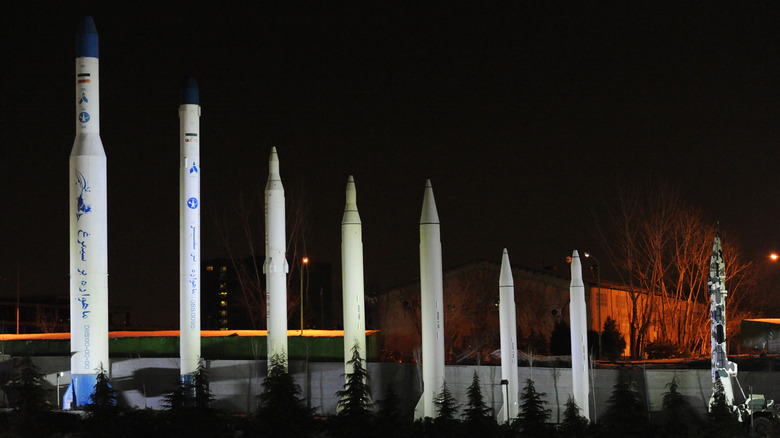How Many Missiles Does Iran Have?
When Israel launched missile strikes hitting Iranian military, nuclear, and civilian targets on June 13, 2025, killing 78 people and injuring over 320, including 20 senior military officials, it ignited a long-simmering conflict between the Middle East's two preeminent military powers. These strikes came just a day after the U.N.'s International Atomic Energy Agency declared that Iran had breached its nonproliferation obligations for the first time in two decades. This cited noncompliance with international investigators and a rising stockpile of enriched uranium, which the global body claimed was approaching weapons-grade levels. In the week that followed, the two countries exchanged a volley of retaliatory strikes, hitting civilian, military, and infrastructure targets alike, and causing nearly 700 deaths to-date. With the specter of the United States' two-week decision deadline hanging over the conflict, many have begun to wonder how long Iran's ballistic stockpiles can hold up in a conflict with its military rival.
Controlled by the Islamic Revolutionary Guard Corps (IRGC), one of Iran's three military branches under the Supreme Leader Ali Khamenei, the Iranian arsenal is an eclectic mix of short and medium-range missiles, employing various propulsion types, ranges, and payloads. Mostly deployed by the IRGC's naval and aerospace divisions, Iran's stockpile has steadily increased since the 1980s, when a conflict with Iraq underscored its lack of retaliatory strike capabilities. In the four decades since, Tehran has built the largest missile arsenal in the Middle East despite Western sanctions, even converting an old cargo ship into a cruise missile-equipped aircraft carrier. At the time of writing, it's estimated that Iran has over 3,000 missiles, in multiple variations.
Missile types
Iran's arsenal is largely made of ballistic missiles, which are launched by rockets and follow an arc trajectory towards their target. U.S. intelligence asserts that Iran deploys several ballistic missiles capable of carrying nuclear warheads. The Iran Watch project, meanwhile, listed at least 16 variations of Iranian ballistic missiles capable of high-payoff strikes. Of particular note are the medium-range Shahab-3 and its more accurate variants, the Ghadr-1 and Emad-1. Cruise missiles, conversely, are powered by jets throughout flight. Although slower, cruise missiles are more difficult for Israel's Iron Dome to intercept because they fly close to the Earth's surface and can change directions. Iran has introduced six over the past decade, including the Fattah 1, which the IRGC claims is a hypersonic cruise missile capable of atmospheric maneuvering.
Iran's missiles use both liquid and solid propellant fuel. While liquid-fueled missiles produce more thrust, their complexity requires robust logistics and on-site fueling, making them more detectable. Conversely, solid fuel missiles are easier to hide, store, and maintain. They also don't require real-time onsite fueling before launch, making them more adept at rapid response and crisis operations.
Ballistic missile types are divided into five range categories, from close (less than 185 miles) to intercontinental (anything above 3,400 miles). Historically, Iran's ballistic missile program focuses on short and medium-range missiles, with strike radiuses between 185 and 1,200 miles, putting the Middle East and much of Eastern Europe within its sights. Tehran's longest-range missiles, the Khorramshahr series, have an estimated range of 1,800 miles — far enough to cover much of Central Europe.
Numbers game
Estimating Iran's missile count is a challenging endeavor. Hazy intelligence and high levels of secrecy make accurate information scarce. While the U.S. estimates that Iran's ballistic missile count is over 3,000, this number doesn't include Tehran's mounting supply of cruise missiles or warheads controlled by Iranian-armed proxies. For what it's worth, Iran's cruise missile numbers are unknown. Israel, for its part, estimated that Iran possessed 2,000 missiles capable of striking its domestic targets.
The better question now may be how many missiles Iran has left in its repertoire. According to recent reports, Iran fired over 520 missiles within the first week of the conflict. If one adds those launched towards Israel in April 2024, that number rises to roughly 700. Israeli officials, meanwhile, estimate that Israeli missile strikes, combined with Iran's high launch rate, have reduced Tehran's remaining firepower by up to 50%. For context, the IDF officials stated on June 19, 2025, that it had destroyed 66% of Iran's missile launchers.
Although Iran has fired fewer daily strikes as the conflict rages on, Tehran appears willing to compensate by using more advanced missiles. On June 18, 2025, for instance, Iran fired its hypersonic Fattah-1 missile — a development that has Israeli officials worried about their depleting Arrow missile interceptors supplies. The IRGC has also reportedly launched its Sejjil ultra-heavy long-range solid-fuel ballistic missile and an unidentified ballistic missile featuring cluster munitions, constituting another major escalation in its offensive powers. Yet to be deployed is the vaunted Khorramshahr-4, widely considered Iran's most powerful warhead, capable of carrying a payload of over one and a half tons.


